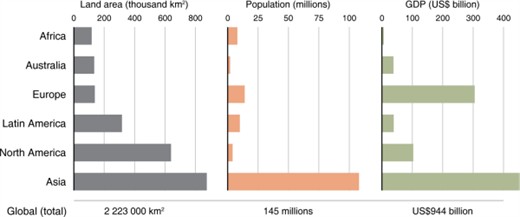

Climate adaptation
Climate change refugees – the human impact
Asia is most affected
Major coastal cities and/or areas with major river deltas where dense populations live and agriculture is productive are most at risk from sea level rise. Most of these areas are in Asia.
Population, area and economy affected by a 1 m sea level rise
 |
Hugo Ahlenius, UNEP/GRID-Arendal
According to the United Nations
Environment Program UNEP, "Even for today's socio-economic
conditions, both regionally and globally, large numbers of people
and significant economic activity are exposed to sea-level rise.
The densely populated megadeltas are especially vulnerable to
sea-level rise.
More than 1 million people living in the Ganges- Brahmaputra,
Mekong and Nile deltas will be directly affected simply if current
rates of sea level rise continue to 2050 and there is no
adaptation. More than 50 000 people are likely to be directly
impacted in each of a further nine deltas, and more than 5000 in
each of a further 12 deltas.
Some 75 per cent of the population affected live on the Asian
megadeltas and deltas, with a large proportion of the remainder
living on deltas in Africa. These impacts would increase
dramatically with accelerated sea level rise."
Impact closer to home
The Pacific includes the smallest and lowest lying nations in
the world. These nations have a high population density, which
means they are extremely vulnerable to sea level rise.
Many Pacific nations are already feeling the effects of sea-level
rise. Without immediate action, these problems will become
widespread throughout the Asia-Pacific region, including
Australia.
- Food
Rising sea levels cause king tides, spring tides and sometimes high tides that increasingly wash through the crop gardens in island communities. Saltwater intrusion reduces food production and has already affected communal crop gardens on six of Tuvalu's eight islands. - Water
People living on coral atolls rely on a thin layer of fresh groundwater that sits atop the saltwater lens. These freshwater reserves are threatened by reduced precipitation rates from changes in climate, as well as sea-level rise. - Infrastructure and land loss
The Tuvaluan Deputy Prime Minister and Minister of Finance and Economic Planning, Mr. Lagitupu Tuilimu, stated in 2001 that scientists have predicted countries like Tuvalu will be totally submerged within around fifty years. Coastal roads, bridges and plantations are already at risk. In Majuro, the capital of the Marshall Islands, the inhabitants were forced to build sea walls to protect existing infrastructure. - Increase in diseases
Warmer surface temperatures will compound the problems of sea-level rise by encouraging the spread of disease. The highlands of Papua New Guinea and Solomon Islands were previously too cold for mosquitoes to survive but with rising temperatures, there have been reports of malaria. Cholera is also a concern with unexpected outbreaks in the Federated States of Micronesia and Marshall Islands over recent years.
More information...
Copyright © Green Cross Australia | Terms & Conditions | Privacy Policy
web design brisbane :: (zero)seven
